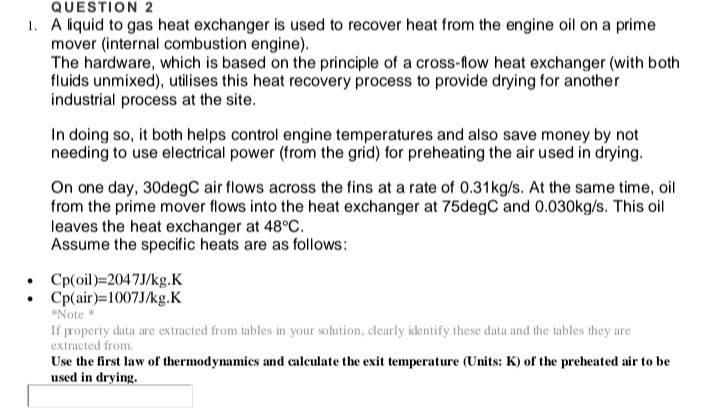A liquid to gas heat exchanger is used to recover heat from the engine oil on a prime mover (internal combustion engine). The hardware, which is based on the principle of a cross-flow heat exchanger (with both fluids unmixed), utilises this heat recovery process to provide drying for another industrial process at the site. In doing so, it both helps control engine temperatures and also save money by not needing to use electrical power (from the grid) for preheating the air used in drying. On one day, 30degC air flows across the fins at a rate of 0.31kg/s. At the same time, oil from the prime mover flows into the heat exchanger at 75degC and 0.030kg/s. This oil leaves the heat exchanger at 48°C. Assume the specific heats are as follows: Cp(oil)=2047J/kg.K Cp(air)=1007J/kg.K "Note If property data are extracted from tables in your solution, clearly identify these data and the tables they are extracted from. Use the first law of thermodynamics and calculate the exit temperature (Units: K) of the preheated air to be used in drying.
A liquid to gas heat exchanger is used to recover heat from the engine oil on a prime mover (internal combustion engine). The hardware, which is based on the principle of a cross-flow heat exchanger (with both fluids unmixed), utilises this heat recovery process to provide drying for another industrial process at the site. In doing so, it both helps control engine temperatures and also save money by not needing to use electrical power (from the grid) for preheating the air used in drying. On one day, 30degC air flows across the fins at a rate of 0.31kg/s. At the same time, oil from the prime mover flows into the heat exchanger at 75degC and 0.030kg/s. This oil leaves the heat exchanger at 48°C. Assume the specific heats are as follows: Cp(oil)=2047J/kg.K Cp(air)=1007J/kg.K "Note If property data are extracted from tables in your solution, clearly identify these data and the tables they are extracted from. Use the first law of thermodynamics and calculate the exit temperature (Units: K) of the preheated air to be used in drying.
Principles of Heat Transfer (Activate Learning with these NEW titles from Engineering!)
8th Edition
ISBN:9781305387102
Author:Kreith, Frank; Manglik, Raj M.
Publisher:Kreith, Frank; Manglik, Raj M.
Chapter10: Heat Exchangers
Section: Chapter Questions
Problem 10.38P
Related questions
Question
Solveee

Transcribed Image Text:A liquid to gas heat exchanger is used to recover heat from the engine oil on a prime
mover (internal combustion engine).
The hardware, which is based on the principle of a cross-flow heat exchanger (with both
fluids unmixed), utilises this heat recovery process to provide drying for another
industrial process at the site.
In doing so, it both helps control engine temperatures and also save money by not
needing to use electrical power (from the grid) for preheating the air used in drying.
On one day, 30degC air flows across the fins at a rate of 0.31kg/s. At the same time, oil
from the prime mover flows into the heat exchanger at 75degC and 0.030kg/s. This oil
leaves the heat exchanger at 48°C.
Assume the specific heats are as follows:
Cp(oil)=2047J/kg.K
Cp(air)=1007J/kg.K
"Note
If property data are extracted from tables in your solution, clearly identify these data and the tables they are
extracted from.
Use the first law of thermodynamics and calculate the exit temperature (Units: K) of the preheated air to be
used in drying.
Expert Solution
This question has been solved!
Explore an expertly crafted, step-by-step solution for a thorough understanding of key concepts.
This is a popular solution!
Trending now
This is a popular solution!
Step by step
Solved in 2 steps

Knowledge Booster
Learn more about
Need a deep-dive on the concept behind this application? Look no further. Learn more about this topic, mechanical-engineering and related others by exploring similar questions and additional content below.Recommended textbooks for you

Principles of Heat Transfer (Activate Learning wi…
Mechanical Engineering
ISBN:
9781305387102
Author:
Kreith, Frank; Manglik, Raj M.
Publisher:
Cengage Learning

Refrigeration and Air Conditioning Technology (Mi…
Mechanical Engineering
ISBN:
9781305578296
Author:
John Tomczyk, Eugene Silberstein, Bill Whitman, Bill Johnson
Publisher:
Cengage Learning

Principles of Heat Transfer (Activate Learning wi…
Mechanical Engineering
ISBN:
9781305387102
Author:
Kreith, Frank; Manglik, Raj M.
Publisher:
Cengage Learning

Refrigeration and Air Conditioning Technology (Mi…
Mechanical Engineering
ISBN:
9781305578296
Author:
John Tomczyk, Eugene Silberstein, Bill Whitman, Bill Johnson
Publisher:
Cengage Learning